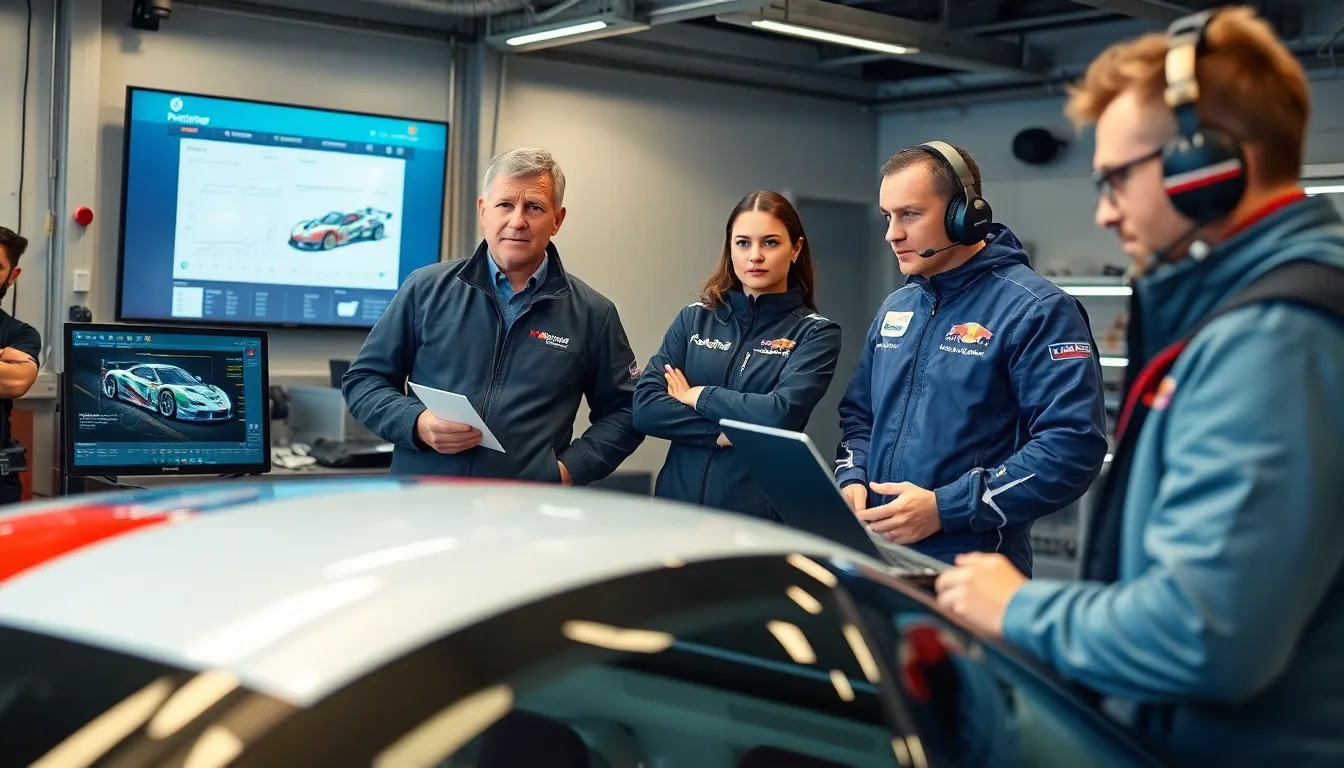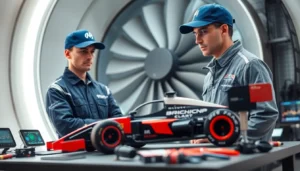Table of Contents
ToggleIn the high-octane world of racing, managing a team isn’t just about fast cars and checkered flags; it’s a thrilling balancing act of strategy, communication, and a dash of chaos. Picture this: a crew of adrenaline junkies fueled by caffeine and ambition, all working together to turn dreams of victory into reality. It’s not just about who crosses the finish line first; it’s about how well the team revs up behind the scenes.
Effective racing team management can mean the difference between glory and a spectacular crash. From coordinating pit stops to keeping team morale high, every detail counts. With the right approach, a team can transform from a group of talented individuals into a well-oiled machine, ready to conquer any track. Buckle up as we dive into the essentials of racing team management, where speed meets strategy and teamwork reigns supreme.
Overview of Racing Team Management
Racing team management involves coordinating multiple components to achieve peak performance on and off the track. Effective management requires establishing a strategy that aligns with team objectives while considering individual strengths. Communication stands out as a vital element in fostering a united team environment.
Team dynamics play a crucial role in achieving success. Crew members must work together seamlessly, often under high-pressure situations. This synergy aids in quick decision-making, especially during critical moments like pit stops. Each team member, from engineers to drivers, contributes to a cohesive effort, enhancing overall performance.
Performance metrics are essential for tracking progress. Data analysis allows teams to identify areas for improvement, ensuring continuous development. Regular assessments of lap times, tire degradation, and fuel efficiency guide strategic adjustments.
Leadership directly impacts team morale and effectiveness. A strong leader motivates individuals while maintaining focus on collective goals. Trust among team members can lead to improved collaboration, which is significant during competitive events.
Additionally, managing resources efficiently contributes to success in racing. Budget considerations influence decisions regarding technology and personnel. Balancing these elements ensures that teams remain competitive in evolving racing environments.
Finally, continuous learning and adaptation prove beneficial for racing teams. The motorsport landscape constantly changes, requiring teams to stay updated on innovations and strategies. Embracing new approaches can provide a competitive edge that sets successful teams apart.
Key Roles in a Racing Team

Racing teams consist of various key roles, each contributing to overall success. Understanding these positions helps clarify their importance in a competitive environment.
Team Principal
The Team Principal oversees all aspects of the racing team. This role involves strategic planning and decision-making to align the team’s objectives with performance goals. They manage resources, budgets, and personnel while maintaining communication between various departments. A strong vision is crucial, as the Principal must motivate the crew to work towards a common goal, ensuring that everyone is on the same page during challenging situations. They also build relationships with sponsors and partners to secure necessary funding and resources.
Technical Director
The Technical Director manages the engineering and technical functions of the team. This role requires an in-depth understanding of vehicle dynamics, aerodynamics, and regulations. They lead the design and development processes, ensuring that cars are optimized for maximum performance. By analyzing data from simulations and on-track testing, the Technical Director influences crucial decisions regarding car setup. Their collaboration with the engineering team fosters an environment focused on innovation and problem-solving, aiming to keep the team competitive and compliant with evolving regulations.
Race Engineer
The Race Engineer acts as the primary communication link between the driver and the technical team during races. This role requires real-time data analysis to make strategic decisions on car adjustments and race tactics. The Engineer coordinates with the driver on performance feedback and monitors telemetry data to optimize performance. Close collaboration with the pit crew is essential for executing timely pit stops and making necessary adjustments. Their ability to adapt strategies based on race conditions directly impacts the team’s race results and overall performance.
Effective Strategies for Racing Team Management
Effective racing team management involves clear strategies that enhance performance and collaboration among team members. Two critical areas warrant attention: communication and driver relationships.
Communication Between Team Members
Communication serves as the backbone of a successful racing team. Open dialogue fosters transparency and builds trust. Daily briefings allow team members to align on goals and strategies, ensuring everyone understands their roles. Utilizing communication tools and technology can streamline information flow, especially during races when rapid decision-making is essential. Regular feedback sessions encourage continuous improvement and help identify potential issues early. By creating an environment where all voices matter, teams can enhance problem-solving capabilities and respond effectively to challenges.
Managing Driver Relationships
Managing relationships with drivers requires awareness and empathy. Drivers benefit from knowing they have the team’s support. Regular one-on-one meetings address concerns and provide a platform for drivers to share insights about their performance. Establishing mutual respect between drivers and team management fosters a collaborative atmosphere, especially during high-pressure situations. Recognizing individual strengths allows for tailored strategies that enhance performance. Furthermore, involving drivers in decision-making promotes a sense of ownership, making them more invested in team success. Overall, strong driver relationships contribute significantly to a team’s cohesiveness and effectiveness.
Challenges in Racing Team Management
Managing a racing team involves navigating several challenges that can impact performance and success.
Budget Constraints
Budget constraints often create significant hurdles for racing teams. Teams must allocate funds carefully across various areas such as vehicle development, staffing, and logistics. Limited budgets lead to tough decisions regarding technology upgrades and hiring skilled personnel. Financial management plays a critical role in maintaining competitiveness and optimizing operations. Teams frequently seek sponsorships and partnerships to bolster resources. Additionally, unexpected expenses, such as repairs or travel costs, can strain already tight budgets, requiring teams to adapt quickly to maintain performance.
Performance Pressure
Performance pressure can significantly affect team dynamics and individual performance. Racing teams face high expectations from stakeholders, sponsors, and fans, with each race magnifying the scrutiny. The intense focus on results often leads to stress among team members and drivers alike. Collaborative support within the team becomes essential for managing this pressure. Continuous communication helps address concerns and fosters resilience. Performance metrics and data analysis become tools for mitigating anxiety, as they provide concrete feedback for improvement. Navigating the highs and lows of competition demand adaptability, making psychological resilience just as crucial as technical skills.
Future Trends in Racing Team Management
Advancements in technology shape the future of racing team management. Data analytics increasingly drives decision-making processes, enabling teams to gain insights from performance metrics and optimize strategies on the fly. Artificial intelligence offers predictive models that can enhance vehicle tuning and race strategy development, allowing teams to adapt in real time during competitions.
Sustainability strategies are also gaining traction. Many teams are exploring eco-friendly alternatives, from fuel-efficient vehicles to renewable energy sourcing for operations. This shift not only addresses environmental concerns but also appeals to sponsors and fans who value responsible practices.
Digital communication tools play a vital role in enhancing team collaboration. Real-time communication platforms streamline information flow, helping team members respond quickly to evolving scenarios on race day. As remote work becomes a norm, integrating digital solutions fosters seamless communication among geographically dispersed teams.
Diversity and inclusion are emerging as essential components of team culture. Racing teams focusing on diverse recruitment not only bring fresh perspectives but also enhance creativity and innovation. Investment in inclusive practices contributes to a more cohesive and dynamic team environment.
Finally, mental performance training is becoming increasingly prioritized. Recognizing the psychological demands placed on drivers and crew members, teams now incorporate mental coaching and resilience training. This approach fosters a positive mindset, which is crucial for managing race-day pressures effectively.
The future of racing team management centers around technology adoption, sustainability initiatives, enhanced communication, diverse team cultures, and mental performance strategies. These trends will likely define how teams operate and compete in the highly competitive racing industry.
Effective racing team management is a multifaceted endeavor that requires a blend of strategy communication and collaboration. By prioritizing these elements teams can navigate the high-pressure environment of racing while maximizing performance.
As the industry evolves embracing new technologies and fostering inclusive cultures will be paramount for future success. Continuous learning and adaptation will not only enhance team dynamics but also ensure teams remain competitive in a rapidly changing landscape.
Ultimately the synergy between skilled individuals and effective management will define the champions of tomorrow.




